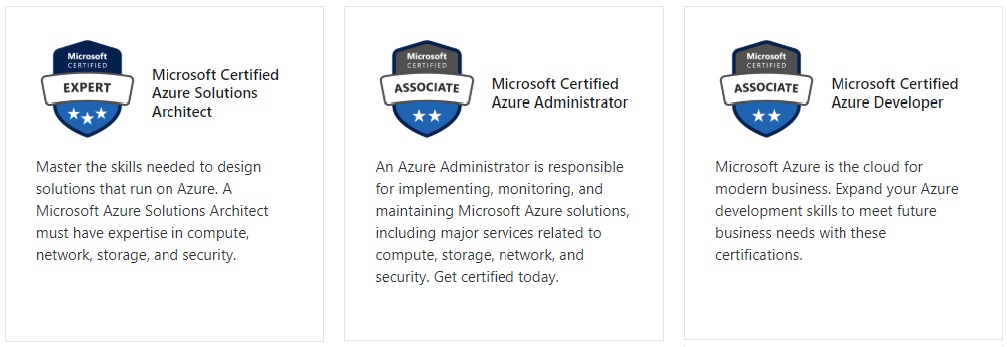Figuring out which Microsoft Azure certification works best for your line of work can help you further your career.
The cloud is expanding and the certified training to work in the cloud is shifting gears to meet these growing needs. Traditional IT certification was based upon expertise within systems.
Microsoft Azure has developed large enough that it is too difficult to become an expert in the entire system. Yet the need for expertise within the system is greater than ever. Therefore, the certifications have become role-based within the overarching Azure platform.
What does this mean for you?
First of all, it means that you need to choose a niche before you jump into training. There are three main roles with a fourth specialty that you have as options.
Microsoft Azure Developer (MCA Azure Developer)
Developers are the programmers of the Azure cloud platform. They create apps and resources for clients to meet the needs of all the businesses who are adopting cloud technology every day.
Developers need to know the possibilities of the Azure platform and have the inspiration to work creatively within those boundaries, creating practical cloud-based solutions for the business needs today.
Microsoft Azure Administrator (MCA Azure Administrator)
Once businesses choose to adopt Azure as their cloud-based platform, capable administrators are needed to make sure that connection, and all the work coming to and from the cloud, is being monitored effectively.
Every business needs at least one administrator who can troubleshoot network errors, find weaknesses in the system, and keep operations running as efficiently as possible. As the saying goes, “time is money.” Administrators work hard to ensure that time (and money) are not wasted in network errors or misdirected operations.
Microsoft Azure Architect (MCE Azure Solutions Architect)
Architects are similar to Developers in their creative roles to problem-solving in cloud-based technology, but they focus more on creating new cloud pathways and networks than in developing apps and programming to fill those networks.
If Developers are like the commercial developers in city planning, Architects are more like the transportation department, making sure the roads lead efficiently to and from all the businesses connected in this work.
Architects are the ones who get projects started, and if needed, come in to do significant network overhaul when the problems grow beyond the capabilities of Administrators. These are mainly employed by larger tech-based corporations.
These three roles function as a kind of mid-range certifications for the Azure cloud-based technology industry. To achieve these certifications, you need first to pass and achieve an Azure fundamentals certification. This is excellent news because it allows you to learn the general workings of Azure before making you choose which role you want to pursue.
You may come in thinking that the Architect role is a great fit for your skills and ambitions, but after taking the Azure Fundamentals course decide that you really are more interested in being a Developer instead. There is time to make those adjustments as you are learning the basics.
Presently, there is another level of certification after these mid-range role-based courses. You move from fundamentals to Associate certification and then have the opportunity to move into expert certification.
In expert certification, Administrators and Developers come together as Engineer Experts. Again, using the city planning example, this is the commercial developers and those who maintain the existing buildings coming together under the same roof as Engineers. Architects, those who work on expanding the Azure cloud network itself, have to achieve this expert-level certification separately before they are certified as Architects.
This means that it takes slightly less work to become a Developer or Administrator than it does to become an Architect because there is no mid-range certification for Architect roles. On the other hand, taking the expert-level Engineer role certification trains you for both Developer and Administrator responsibilities.
What is the difference between these two major paths? Engineers (Developers and especially Administrators) are more likely to work closer to business clients. Architects will often work through third-party mediators, larger tech firms, perhaps Microsoft itself. The needs they are working to meet typically go beyond the scope of an individual business.
Azure Hybrid Stack Operator
The last role is a specialty role, similar to Administrators, but expanded on as well. Azure Hybrid Stack Operators are those trained to work in specific businesses who wish to do part of their business in the cloud, but retain part within their own servers as well.
This hybrid of server-cloud technology is common among larger enterprises who have sensitive data or who cannot risk moving entirely into the cloud platform yet, so there is plenty of work out there for these hybrid stack operators. They have to train to have a foot in both worlds and, at the moment, are trained to be a generalist in this context.
These are the major roles in play today, but Microsoft has promised more to come. With the expansion of cloud technology, it is probably safe to expect that further expertise will be required, perhaps even within the next year, and some of these roles may be split into separate pathways.
Start with Azure Fundamentals, learn the platform’s general workings, choose the role that suits your skills and interests, and achieve the certification that will put you on the path to being a part of the expanding world of Azure cloud technology.

